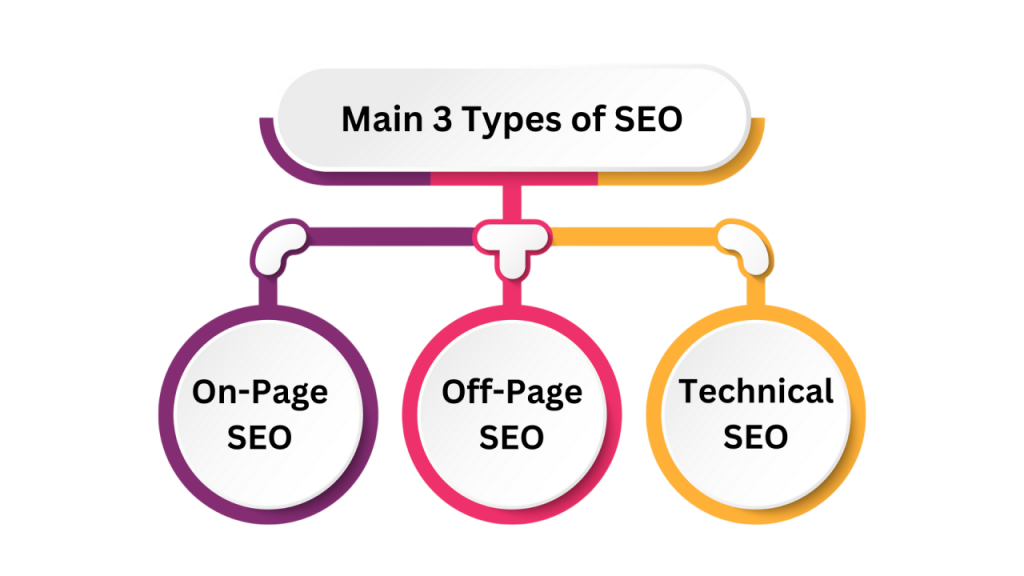
- Introduction to SEO
- Why SEO Matters
- The Main Types of SEO
- Additional SEO Types
- Comparing the Types of SEO
- How the Types of SEO Work Together
- Common SEO Mistakes to Avoid
- Best Practices for Implementing All SEO Types
- SEO Tools for Each Type
- Conclusion
Introduction to SEO
Search Engine Optimization (SEO) is the process of improving your website’s visibility on search engines like Google, Bing, and Yahoo. When done correctly, SEO helps your site rank higher in search engine results pages (SERPs), bringing in more organic (unpaid) traffic. SEO isn’t a one-size-fits-all solution. It’s a combination of strategies and practices divided into various types, each with a specific purpose. Understanding these types helps you craft a complete SEO strategy.Search Engine Optimization (SEO) is the practice of improving a website’s visibility on search engines like Google, Bing, Digital Marketing Training and Yahoo. The goal of SEO is to increase organic (non-paid) traffic by making a site more attractive and relevant to search engines and users. This involves optimizing various elements such as content, keywords, site structure, and technical aspects to help search engines better understand and rank the website. Effective SEO not only boosts a site’s position in search results but also enhances the user experience, making it easier for visitors to find the information they need. Because search engines are a major source of online traffic, mastering SEO is essential for businesses and individuals who want to grow their online presence and reach their target audience.
Ready to Get Certified in Digital Marketing? Explore the Program Now Digital Marketing Online Training Offered By ACTE Right Now!
Why SEO Matters
In today’s digital landscape: 93% of online experiences begin with a search engine. 75% of users never scroll past the first page of results. Organic traffic converts better than paid traffic. SEO is crucial because it helps users find your business, builds trust, and improves the overall user experience on your site.SEO matters because it helps websites become more visible to people searching for relevant information, Digital Marketing Components products, or services online. Since the majority of online experiences begin with a search engine, ranking higher in search results increases the chances that users will visit your site instead of your competitors’. Good SEO drives organic traffic, which is often more valuable and cost-effective than paid advertising because it targets users actively looking for what you offer. Additionally, SEO improves user experience by making websites faster, easier to navigate, and more relevant to search intent. In short, SEO is essential for growing your online presence, building credibility, and attracting quality visitors who are more likely to convert into customers or followers.
The Main Types of SEO
Let’s start with the three core types of SEO:
On-Page SEO
- Definition: On-page SEO involves optimizing the content and HTML source code of individual pages to rank higher and earn more relevant traffic. Key elements: Keyword Optimization Using relevant keywords in titles, headers, and body text. Meta Tags Writing compelling meta titles and meta descriptions. Internal Linking Connecting pages within your website. Content Quality Creating valuable, original, and in-depth content. Image Optimization Compressing images and adding alt text. Goal: Make your content easy for both users and search engines to understand.
- Definition: Off-page SEO refers to activities performed outside your website to improve its authority and ranking. Key elements: Backlink Building Acquiring links from high-authority websites. Social Media Signals Mentions, shares, Top Digital Marketing Experts and engagement from social networks. Influencer Outreach Partnering with influencers to amplify your brand. Guest Blogging Writing articles for other websites with links back to yours. Goal: Increase your website’s credibility and trustworthiness in the eyes of search engines.
- Definition: Technical SEO focuses on improving the technical aspects of your website to enhance its crawlability, indexability, and user experience. Key elements: Site Speed Faster load times for better user experience. Mobile Optimization Ensuring your site works well on all devices. XML Sitemaps Helping search engines crawl your site. SSL (HTTPS) Adding a secure connection. Structured Data Using schema markup for rich results. Goal: Make your site easier for search engines to access and understand.
- Definition: Local SEO helps businesses appear in local search results (e.g., “dentist near me”). Key elements: Google Business Profile (formerly Google My Business), local citations (Name, Address, Phone Number consistency), TensorFlow local keywords, reviews and ratings. Best for: Brick-and-mortar businesses, local service providers.
- Definition: Mobile SEO ensures your website is fully optimized for smartphones and tablets. Key elements: Responsive design, fast mobile load times, easy navigation on small screens, mobile-friendly popups. Why it matters: Google uses mobile-first indexing, meaning it primarily ranks your mobile version.
- Definition: Ecommerce SEO is the process of making an online store more visible in search engine results. Key elements: Product page optimization, unique product descriptions, schema markup for products, navigation and filter-friendly URLs, optimized images for each product. Platforms supported: Shopify, WooCommerce, Magento, etc.
- Definition: Enterprise SEO is large-scale SEO typically for websites with thousands of pages. Key challenges: Managing duplicate content, Choose a Career in Digital Marketing scalable optimization, automation tools, large team collaboration. Goal: Improve visibility for high-traffic websites with complex architectures.
- Definition: This type of SEO optimizes your content to appear in voice search results from devices like Alexa, Siri, and Google Assistant. Key elements: Conversational keywords, featured snippets optimization, fast-loading pages, FAQ content formats. Why it’s growing: With over 1 billion voice searches per month, this is a major trend.
- Definition: Optimizing your YouTube videos for search both within YouTube and on Google. Key elements: Keywords in titles and descriptions, tags and categories, high engagement (likes, comments), thumbnails, paid traffic and closed captions. Goal: Get your videos discovered more easily.
Off-Page SEO

Technical SEO
To Explore Digital Marketing in Depth, Check Out Our Comprehensive Digital Marketing Training To Gain Insights From Our Experts!
Additional SEO Types
Besides the three core types, there are specialized SEO practices that target specific needs and audiences.
Local SEO
Mobile SEO
Ecommerce SEO
Enterprise SEO
Voice Search SEO
YouTube SEO (Video SEO)
Comparing the Types of SEO
| SEO Type | Focus Area | Best For |
|---|---|---|
| On-Page SEO | Content and page-level elements | All websites |
| Off-Page SEO | External authority and links | Building domain credibility |
| Technical SEO | Website infrastructure | Improving crawlability and performance |
| Local SEO | Geographic relevance | Small/local businesses |
| Mobile SEO | Mobile usability | All websites (especially mobile-heavy) |
| Ecommerce SEO | Online product sales | Online stores |
| Enterprise SEO | Large-scale optimization | Big brands and enterprise websites |
Looking to Master Digital Marketing? Discover the Digital Marketing Expert Masters Program Training Course Available at ACTE Now!
How the Types of SEO Work Together
While each type has its own purpose, they’re all interconnected. For example: Technical SEO ensures your site is crawlable. On-page SEO ensures your content is keyword-rich and engaging. Off-page SEO builds authority so that Google trusts your site. A complete SEO strategy uses all types to cover the full spectrum of visibility and performance.SEO is made up of three main types On-Page SEO, Off-Page SEO, Digital Marketing Training and Technical SEO and they work together to improve a website’s overall performance in search engines. On-Page SEO focuses on optimizing the content and structure of your pages, such as using relevant keywords, creating quality content, and organizing headings. Off-Page SEO involves building your site’s reputation and authority through backlinks and social signals from other trusted websites.
Meanwhile, Technical SEO ensures that search engines can easily crawl, index, and understand your site by improving aspects like site speed, mobile-friendliness, and secure connections. When all three types are effectively combined, they create a strong foundation that helps your website rank higher, attract more visitors, and provide a better user experience.
Common SEO Mistakes to Avoid
Ignoring technical SEO fundamentals, keyword stuffing in content, building low-quality or spammy backlinks, not optimizing for mobile users, failing to update outdated content, overlooking local search optimization, and using duplicate content across pages. Avoiding these mistakes helps all types of SEO perform better together.Many websites struggle with SEO because of common mistakes that can hurt their search rankings. One frequent error is keyword stuffing, which means overusing keywords in a way that feels unnatural to readers and can lead to penalties. Another is neglecting mobile optimization, SEO Strategies even though most users now browse on smartphones. Poor site speed and complicated navigation also frustrate visitors and lower rankings. Additionally, ignoring meta tags like title tags and descriptions can reduce click-through rates from search results. Failing to build quality backlinks or using spammy links can harm your site’s authority. Lastly, not regularly updating content or monitoring SEO performance means missed opportunities to improve. Avoiding these mistakes helps create a better user experience and stronger search engine rankings.
SEO Tools for Each Type
| SEO Type | Recommended Tools |
|---|---|
| White Hat | Ethical SEO following search guidelines |
| On-Page SEO | Yoast SEO, Surfer SEO, SEMrush, Clearscope |
| Off-Page SEO | Ahrefs, Moz, BuzzSumo, NinjaOutreach |
| Technical SEO | Screaming Frog, Google Search Console, GTmetrix, Sitebulb |
| Local SEO | BrightLocal, Whitespark, Moz Local |
| Mobile SEO | Google Mobile-Friendly Test, PageSpeed Insights |
| Ecommerce SEO | Ahrefs, SEMrush, Google Merchant Center |
| Enterprise SEO | Botify, Conductor, Deepcrawl |
Best Practices for Implementing All SEO Types
Start with a strong technical foundation. Publish high-quality, keyword-optimized content regularly. Build authoritative backlinks through ethical outreach. Optimize for local and mobile users. Use structured data to enhance search appearance. Monitor and update your strategies based on analytics. Stay current with algorithm updates and SEO trends.To get the best results from SEO, it’s important to implement On-Page, Off-Page, and Technical SEO together in a balanced way. For On-Page SEO, focus on creating high-quality, relevant content with well-researched keywords, clear headings, SEO Keyword Research and optimized meta tags. Off-Page SEO should include building natural backlinks from reputable websites and engaging with your audience on social media to boost your site’s authority. For Technical SEO, ensure your website loads quickly, is mobile-friendly, has a clear site structure, and uses secure HTTPS connections. Regularly audit your site to fix broken links, improve crawlability, and update content as needed. Combining these practices creates a solid foundation that improves search rankings, attracts more visitors, and offers a great user experience.
Preparing for Digital Marketing Job Interviews? Have a Look at Our Blog on Digital Marketing Interview Questions and Answers To Ace Your Interview!
Conclusion
SEO isn’t just one tactic, it’s a comprehensive ecosystem made up of multiple types, SEO Mistakes to Avoid, each essential to overall success. From optimizing individual pages (on-page) to making your site technically sound , organic traffic and earning credibility through off-page efforts, paid traffic, Digital Marketing Training every SEO Tools plays a vital role. Understanding the different types of SEO helps you create a well-rounded strategy that increases visibility, drives traffic, Implementing All SEO Types and grows your business over time.





